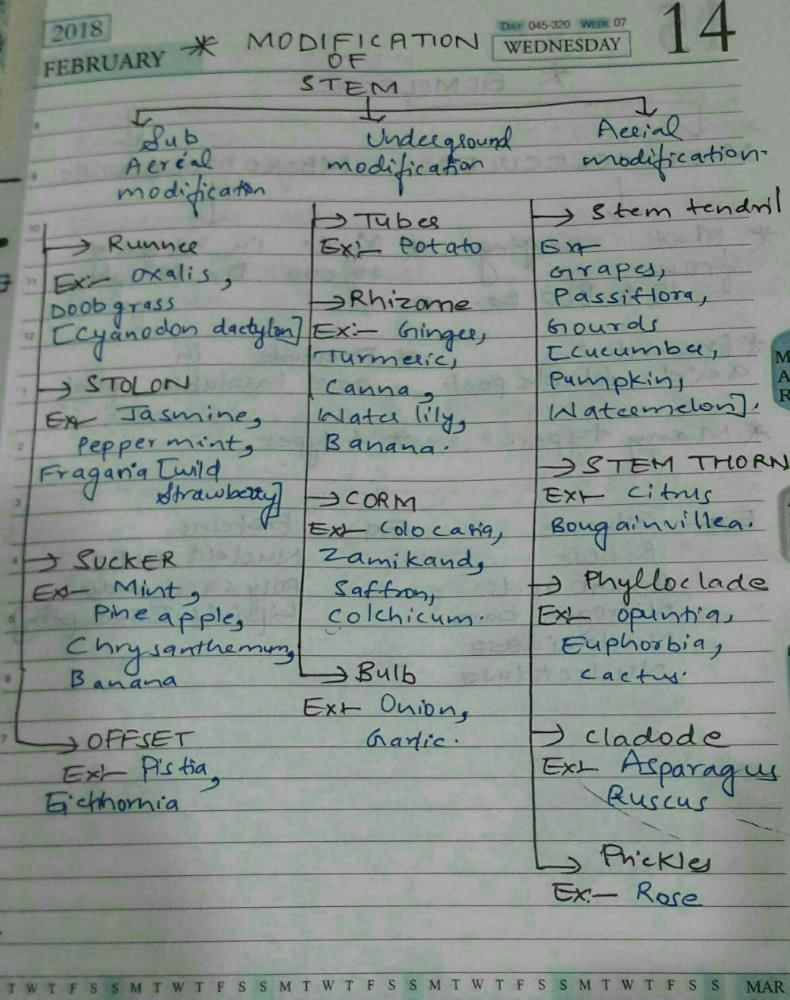NEET Exam > NEET Questions > In Opuntia the stem isa)Cladodeb)Phyllodadec)...
Start Learning for Free
In Opuntia the stem is
a)Cladode
b)Phyllodade
c)Phylloclade
d)Staminode
Correct answer is option 'C'. Can you explain this answer?
| FREE This question is part of | Download PDF Attempt this Test |
Most Upvoted Answer
In Opuntia the stem isa)Cladodeb)Phyllodadec)Phyllocladed)StaminodeCor...

Free Test
FREE
| Start Free Test |
Community Answer
In Opuntia the stem isa)Cladodeb)Phyllodadec)Phyllocladed)StaminodeCor...
In Opuntia, the stem is phylloclade. Let's understand what a phylloclade is and why it is the correct answer for this question.
Phylloclade:
A phylloclade is a modified stem that performs the functions of a leaf. It is a flattened, green, photosynthetic structure that resembles a leaf in appearance and function. Phylloclades have the ability to carry out photosynthesis, just like leaves, and help in the production of food for the plant.
Explanation:
Opuntia belongs to the family Cactaceae, and it is commonly known as the prickly pear cactus. The stem of Opuntia is modified into a phylloclade, which is an adaptation to withstand arid conditions. The transformation of the stem into a phylloclade helps the plant to conserve water and reduce transpiration.
Opuntia plants have reduced or absent leaves, and the stem takes up the role of photosynthesis. The stem is flattened and fleshy, with spines and glochids (tiny barbed hairs) for protection against herbivores. The phylloclades of Opuntia are green and succulent, allowing the plant to carry out photosynthesis efficiently.
The presence of phylloclades in Opuntia is an example of convergent evolution, where plants from different lineages independently evolve similar adaptations to survive in arid environments. Other examples of plants with phylloclades include some species of Euphorbia, Ruscus, and Asparagus.
In conclusion, the stem of Opuntia is modified into a phylloclade, which resembles a leaf in appearance and functions as the primary site for photosynthesis. This adaptation allows Opuntia to thrive in arid conditions by reducing water loss through transpiration.
Phylloclade:
A phylloclade is a modified stem that performs the functions of a leaf. It is a flattened, green, photosynthetic structure that resembles a leaf in appearance and function. Phylloclades have the ability to carry out photosynthesis, just like leaves, and help in the production of food for the plant.
Explanation:
Opuntia belongs to the family Cactaceae, and it is commonly known as the prickly pear cactus. The stem of Opuntia is modified into a phylloclade, which is an adaptation to withstand arid conditions. The transformation of the stem into a phylloclade helps the plant to conserve water and reduce transpiration.
Opuntia plants have reduced or absent leaves, and the stem takes up the role of photosynthesis. The stem is flattened and fleshy, with spines and glochids (tiny barbed hairs) for protection against herbivores. The phylloclades of Opuntia are green and succulent, allowing the plant to carry out photosynthesis efficiently.
The presence of phylloclades in Opuntia is an example of convergent evolution, where plants from different lineages independently evolve similar adaptations to survive in arid environments. Other examples of plants with phylloclades include some species of Euphorbia, Ruscus, and Asparagus.
In conclusion, the stem of Opuntia is modified into a phylloclade, which resembles a leaf in appearance and functions as the primary site for photosynthesis. This adaptation allows Opuntia to thrive in arid conditions by reducing water loss through transpiration.
Attention NEET Students!
To make sure you are not studying endlessly, EduRev has designed NEET study material, with Structured Courses, Videos, & Test Series. Plus get personalized analysis, doubt solving and improvement plans to achieve a great score in NEET.

|
Explore Courses for NEET exam
|

|
Similar NEET Doubts
In Opuntia the stem isa)Cladodeb)Phyllodadec)Phyllocladed)StaminodeCorrect answer is option 'C'. Can you explain this answer?
Question Description
In Opuntia the stem isa)Cladodeb)Phyllodadec)Phyllocladed)StaminodeCorrect answer is option 'C'. Can you explain this answer? for NEET 2024 is part of NEET preparation. The Question and answers have been prepared according to the NEET exam syllabus. Information about In Opuntia the stem isa)Cladodeb)Phyllodadec)Phyllocladed)StaminodeCorrect answer is option 'C'. Can you explain this answer? covers all topics & solutions for NEET 2024 Exam. Find important definitions, questions, meanings, examples, exercises and tests below for In Opuntia the stem isa)Cladodeb)Phyllodadec)Phyllocladed)StaminodeCorrect answer is option 'C'. Can you explain this answer?.
In Opuntia the stem isa)Cladodeb)Phyllodadec)Phyllocladed)StaminodeCorrect answer is option 'C'. Can you explain this answer? for NEET 2024 is part of NEET preparation. The Question and answers have been prepared according to the NEET exam syllabus. Information about In Opuntia the stem isa)Cladodeb)Phyllodadec)Phyllocladed)StaminodeCorrect answer is option 'C'. Can you explain this answer? covers all topics & solutions for NEET 2024 Exam. Find important definitions, questions, meanings, examples, exercises and tests below for In Opuntia the stem isa)Cladodeb)Phyllodadec)Phyllocladed)StaminodeCorrect answer is option 'C'. Can you explain this answer?.
Solutions for In Opuntia the stem isa)Cladodeb)Phyllodadec)Phyllocladed)StaminodeCorrect answer is option 'C'. Can you explain this answer? in English & in Hindi are available as part of our courses for NEET.
Download more important topics, notes, lectures and mock test series for NEET Exam by signing up for free.
Here you can find the meaning of In Opuntia the stem isa)Cladodeb)Phyllodadec)Phyllocladed)StaminodeCorrect answer is option 'C'. Can you explain this answer? defined & explained in the simplest way possible. Besides giving the explanation of
In Opuntia the stem isa)Cladodeb)Phyllodadec)Phyllocladed)StaminodeCorrect answer is option 'C'. Can you explain this answer?, a detailed solution for In Opuntia the stem isa)Cladodeb)Phyllodadec)Phyllocladed)StaminodeCorrect answer is option 'C'. Can you explain this answer? has been provided alongside types of In Opuntia the stem isa)Cladodeb)Phyllodadec)Phyllocladed)StaminodeCorrect answer is option 'C'. Can you explain this answer? theory, EduRev gives you an
ample number of questions to practice In Opuntia the stem isa)Cladodeb)Phyllodadec)Phyllocladed)StaminodeCorrect answer is option 'C'. Can you explain this answer? tests, examples and also practice NEET tests.

|
Explore Courses for NEET exam
|

|
Suggested Free Tests
Signup for Free!
Signup to see your scores go up within 7 days! Learn & Practice with 1000+ FREE Notes, Videos & Tests.
























